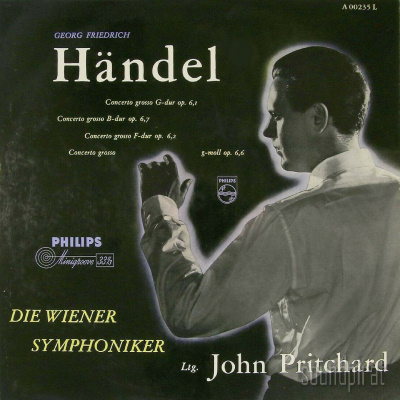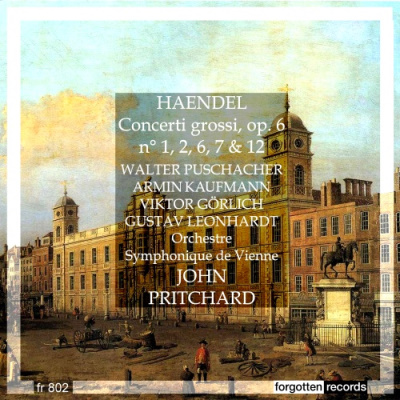 |
|
1 LP -
A 00235 L - (p) 1956
|
 |
| 1 CD -
fr 802 - (p) 2013 |
|
CONCERTOS
|
|
|
|
|
|
|
|
| Georg Friedrich
HÄNDEL (1685-1759) |
Concerto
Grosso in G major, Op. 6 No. 1 |
|
12' 00" |
A1 |
|
-
A tempo giusto · Allegro · Adagio ·
Allegro · Allegro
|
|
|
|
|
Concerto
Grosso in B-flat major, Op. 6 No. 7 |
|
13' 38" |
A2 |
|
- Largo ·
Allegro · Largo e piano ·
Andante · Hornpipe |
|
|
|
|
Concerto Grosso
in F major, Op. 6 No. 2 |
|
11' 54" |
B1 |
|
-
Andante Larghetto ·
Allegro · Largo ·
Allegro, ma non
troppo
|
|
|
|
|
Concerto
Grosso in G minor, Op. 6 No. 6
|
|
15' 50" |
B2 |
|
-
Larghetto e
affettuoso · Allegro
ma non troppo ·
Musette · Allegro ·
Allegro
|
|
|
|
|
|
|
|
|
Concertino:
- Walter Puschacher, first violin
- Armin Kaufmann, second violin
- Viktor Görlich, 'cello
- Gustav Leonhardt, harpsichord |
The "WIENER
SYMPHONIKER" (The Vienna Symphony
Orchestra)
John PRITCHARD,
Conductor
|
|
|
|
|
|
Luogo
e data di registrazione |
|
(luogo di
registrazione non indicato) - 1954
|
|
|
Registrazione: live
/ studio |
|
studio |
|
|
Recording
Supervision |
|
-
|
|
|
Engineer |
|
-
|
|
|
Prima Edizione LP |
|
Philips Minigrove | A
00235 L | 1 LP - durata 53' 22" |
(p) 1956
|
|
|
Edizione CD |
|
Forgotten Records |
fr 802 | 1 CD - durata 67' 26" |
(p) 2013 | ADD |
|
|
Cover Art
|
|
-
|
|
|
Note |
|
-
|
|
|
|
|
The concerto
grosso, as a specifically
Baroque form of orchestral
composition, occupies a
unique place in the history
of the concerto. The first
record of this type of work
is met with among the music
of the oratorio and opera
composer Alessandro
Stradella around about 1680,
who wrote a number of
concerti grossi for string
orchestra with harpsichord
accompaniment. The violinist
Arcangelo Corelli
(1653-1713) is reputed to
have taken over this form
from its originator. It has
also been discovered that
Corelli, when he was Music
Director to Queen Christine
of Sweden in Rome, and
subsequently in the service
of the Duke of Modena,
conducted this type of
concerto at the head of up
to 150 players. It was
during this period that he
became acquainted with the
young Handel. No one less
than Georg Muffat
(1645-1704) expressed his
great admiration for
Corelli's orchestral
technique, especially for
the way in which he divided
up the various sound groups;
it is assumed that he learnt
the principles of this
during a personal visit to
Lully in Paris in 1672. This
then is the history of the
formal evolution of the
concerto grosso, as Handel
first came to know it. And
now a few words about the
actual characteristics of
the form itself.
The concerto grosso is
written for two orchestra
groups, played on the
strings. The multiscored
string group of the full
orchestra bears the brunt of
the Ripieno work and forms
the basis, as it were of the
composition, which explains
why it is referred to as
"Concerto grosso". The
contrasting element to this
full orchestra is a smaller
group, also consisting of
strings, which being a
soloist ensemble is singly
scored and is known as the
"Concertino". Usually, as is
evident from Handel's works,
it consists of two solo
violins, a solo 'cello and a
thorough-bass, played on the
harpsichord.
As the well-known
musicologist Hans Joachim
expressed it so perfectly,
the two orchestral groups
engage, to a certain extent
like a double chorus, in a
brilliant dialogue, during
which the Concertino, due to
its greater flexibility and
virtuoso qualities,
colourfully enlarges on the
main thematic material. The
full (Ripieno) orchestra is
often completely silent in
the central movement,
leaving the soloists to
continue the tale.
The four concerti grossi
recorded here are part of a
series of twelve major
concertos, which Handel
composed in 1739 as Opus 6.
They represent a major
milestone in the master's
instrumental compositions.
Influenced by the Italian
stylistic ideals of the
"Venetian" and "Neapolitan"
schools, he also infuses the
music with his Germanic
natural feelings and the
portrayal of human
individuals, thereby
bringing music to one of the
summits of its overall
development. As opposed to
Bach's gothic approach, the
language Handel uses (and
this is not only accounted
for by his studies in Italy)
is transparently clear in
the Renaissance sense,
forthright and, seen from
our point of view, like
Baroque. As far as the
performance of the Handel
works are concerned, the
concerti grossi are heard
here in their original
setting, without any
re-arranging or
re-orchestration whatsoever.
If one had wished to use a
large string orchestra for
the Ripieno, this would have
necessitated including more
harpsichords (the modern
piano tone was impossible on
acount of stylistic
considerations). We,
therefore, have confined
ourselves to one harpsichord
and the old, small
orchestra. This reflects the
sound colour of the Ripieno
in all its tonal
characteristics so
transparently abd airily,
just as it must have sounded
in Handel's time; as a
result, the correct tonal
balance between the Ripieno
and the Concertino is
ensured. The proper
execution of a work after
all is nothing but an
historically true return and
re-introduction of the
strict Baroque style.
CONCERTO GROSSO No. 1 in G
MAJOR, is in five movements.
Two themes are ireely
contrasted with one another
in the introductory Tempo
giusto - the rhythmically
pointed Ripieno theme
accentuates the melodious
motif of the Concertino,
which is imitated by the
solo violins. The solo
'cello and the harpsichord
provide the harmonic,
chordal foundation. An
entirely different composing
technique is adopted in the
ensuing Allegro. The
rondo-like double measure
motif is dynamically
differentiated in alternate
interplay of question and
answer between the Ripieno
and the Concertino and
varied, the whole resting
upon a basis of moving
quavers in the bass.
In the following lyrical
mellifluous scene, the two
solo violins embroider upon
an E flat major Adagio,
against the counterpoint of
the solo 'cello. The
entrances of the ripieno are
to be regarded as
interconnecting links
between the theme entrances.
A four-best Adagio return
modulation leads to a freely
developed fugue, which, in
addition to normal theme
entries, also elaborates on
motif aspects as in a
development. Canonically
developed intermediate
episodes in the Concertino
provide the necessary
variety. The work concludes
with a figuratively richly
fashioned Allegro.
CONCERTO GROSSO No. 7 IN B
FLAT MAJOr is formally the
most interesting. A short
introductory Largo serves as
a prelude to the B flat
major fugue (Allegro). The
form is strongly reminiscent
of Bach with three distinct
sections and two entractes.
The special melodic
independence of the central
voices is the most striking
aspect of the three-part,
freely fashioned Largo in G
minor. In the following,
rhythmically pregnant
Andante, the fully composed
steps of the key are
developed full of rich,
harmonic variety. Handel
brings this work to a
conclusion with a lively
hornpipe abounding with the
closely tied rhythms,
characteristic if this form.
CONCERTO GROSSO No. 2 IN F
MAJOR is marked by the rich
interplay of keys. Handel
opens this work with an
interesting amalgamation of
polyphonic imitation and
"Lied" form (Andante
larghetto, F major), in
which the Concertino plays a
leading role. In the
Allegro, D minor, he changes
ove to the parallel key and
introduces a typical violin
theme in which chords play a
prominent part, interwoven
in the contrasting repartee
between the Concertino and
the Ripieno. The Largo in B
flat major, is also
characterized by a similar
contrasting interplay
between. Tutti and Solo
(restricted here to the
dynamic aspects). The
composer returns to the
original key of F major in
the final movement, Allegro
ma non troppo, and this
Concerto grosso finishes
impressively in strict fugal
form.
In the CONCERTO GROSSO No. 6
IN G MINOR, in which the
introductory,
freely-developed Larghetto e
affettuoso reveals a
fascinating interplay of
Tutti and Solo, the serious
character of the work is
clearly stressed. He
compresses his thoughts in
the succeeding Allegro ma
non troppo, a brief, rather
chromatic fugue, in which
the soloist and Tutti
antries alternate with one
another. Special attention
should be paid to the
stylized dance section
(Musette - Larghetto - E
flat major), which makes
full advantage of the
colourful possibilities of a
full-toned string ensemble,
while the soloists of the
Concertino perform canonic
imitations. Towards the end
of the three-sectional
movement, the violins switch
over from the marked musette
rhythm to a running
semiquaver movement. In the
following Allegro in G
minor, the style of the
composition already referred
to is maintained, in that
the movement gains in
liveliness as it proceeds.
In the final movement
(Allegro) this liveliness is
reflected in triplets,
adding a warm and cheerful
note to the serious
character of the music.
····················
The
orchestral supervision of
the recording was entrusted
to a prominent Baroque
expert, who studied Handel's
own particular composing
style at the place where the
latter created these works,
in London: JOHN PRITCHARD,
one of the most important
contemporary British
conductors.
Convincing and flexible in
the shaping of the formal
structure, Pritchard
magically recreates the
part-progression wonders of
the Baroque period for us,
so that, on hearing this
record, we find ourselves
confronted with new,
undiscovered beauties in
this work, which the
excellence of the recording
allows us to enjoy to the
full. He is assisted by
equally brilliant Concertino
and Ripieno musicians of the
VIENNA SYMPHONY ORCHEsTRA,
whose technical mastery
allows them to follow
faithfully every nuance of
the conductor's wishes in
the matter of style, thereby
achoeving, with him, a
masterpiece of musical
reproduction.
|
  |
|
|